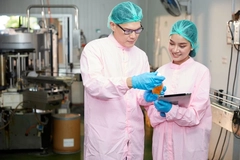FAO spearheads nutritional food systems program in Tajikistan

The FAO has launched a two-year joint program to reshape food systems for better nutrition in Tajikistan. One of the project’s core objectives is to introduce innovative local solutions that transform the way food is produced, processed, and consumed.
FAO expects this program will directly benefit more than 17,000 people and indirectly reach over two million people across Tajikistan.
“By transforming our food systems through innovation, inclusivity, and sustainability, we will build a healthier and more resilient Tajikistan for future generations,” says Mahmud Shirinjonzoda, the First Deputy Chairman of the Committee for Food Security under the Government of Tajikistan.
“This initiative marks a turning point in our national effort to ensure that every citizen, especially those in our most vulnerable communities, has access to nutritious, locally produced food that is rooted in our values and guided by a shared vision.”
Program kicks off in Dushanbe
The program was launched during a joint steering committee meeting convened in Dushanbe. At the meeting, the project’s partners agreed on a unified food systems approach to guide its implementation.
They reviewed and endorsed a comprehensive draft work plan detailing key outputs and priority interventions. The document includes recommendations to accelerate implementation and drive tangible progress toward improved nutrition outcomes.
The program is financed by the Joint SDG Fund, a UN mechanism designed to accelerate progress toward the Sustainable Development Goals (SDGs). The main implementing UN agencies are the FAO, the UN Children’s Fund, the WHO, and the World Food Programme.
“Transforming food systems is one of the critical accelerators for advancing the SDGs,” says Parvathy Ramaswami, UN Resident Coordinator in Tajikistan.
“Since 2021, the UN has been partnering with the Government of Tajikistan to advance food systems priorities. I am delighted that our collaboration will be continued within this joint program, supporting the government’s cross-sectoral approach and introducing innovative solutions for food systems transformation and improved nutrition.”
The joint program will leverage existing national strategies and international best practices while using coordination mechanisms under the Scaling Up Nutrition Movement, one of the project’s partners.
Other partners include Tajikistan’s Ministry of Health and Social Protection, the Ministry of Agriculture, the Ministry of Economic Development and Trade, the Ministry of Education and Science, the Ministry of Industry and New Technologies, the State Committee on Investments and State Property Management, international finance institutions, development partners, and embassies.
Speaking to Nutrition Insight in a previous interview, one FAO economist flagged that nutrition is virtually “invisible” in global finance architecture. One major issue is the highly technical language used in the financial world, which often causes a rift between commercial-oriented and development-oriented stakeholders of the financing system.












